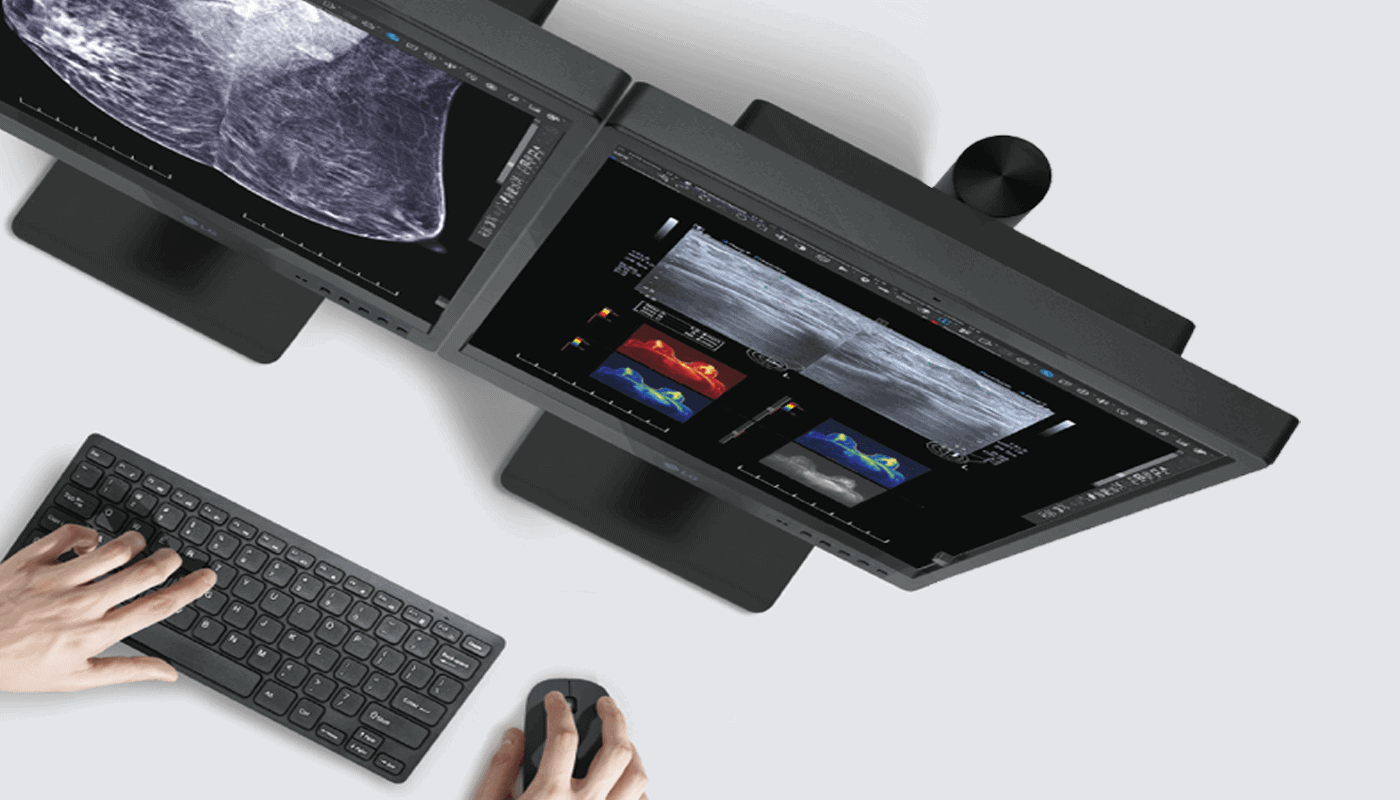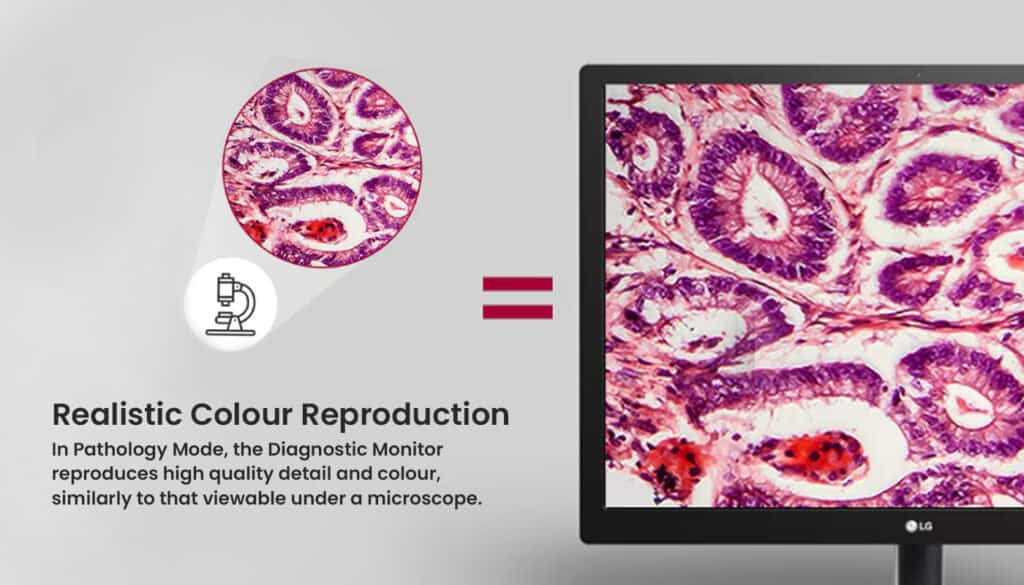- 27/09/2024
- by Miguel Sabater
Benefits of using Diagnostic Display Monitors in Healthcare

Medical Display Monitor plays a vital role in improving patient outcomes. By offering enhanced image quality, which allows for more accurate diagnoses and treatment decisions. By choosing medical-grade monitor, you’re not only ensuring the best for your patients but also enhancing the efficiency and effectiveness of your medical practice.
What are the advantages of diagnostic display monitors? It’s a question that we get asked on a near-daily basis by radiologists, healthcare IT professionals, buyers for medical groups, and hospital administrators. Why should I pay for medical display monitor when there are seemingly high-quality consumer-grade options on market that cost less? With all the advances in commercial off-the-shelf (COTS) display technology, is there really that much of a difference between the two options?
Although it may appear, that COTS display technologies have closed the gap, the answer to whether there’s still a meaningful difference is a resounding yes.
Here’s a simple, less technical explanation for why higher-end, higher-cost medical-grade displays are superior in diagnostic applications, and why your hospital or radiology practice should choose them:
1. Better patient outcomes
COTS displays are intended for a wide variety of applications in our everyday lives and standard office environments—in other words, activities that don’t require the best visualization capabilities and highest level of detail.
However, medical-grade displays were designed and built specifically for the clinical environment—where quality, consistency, and accuracy are, literally, matters of life and death. For radiologists, their work is all about what they can see, so the smallest details have to be visible. Radiologists’ interpretations impact courses of treatment. Sub-standard technology can result in misdiagnoses and have a negative effect on patient outcomes. Way too much is at stake to gamble on a consumer-grade product that was never intended for diagnostic applications.

2. Improved image quality through Medical Display Monitors
Screen resolution
Additionally, no panning or zooming in and out is necessary, which saves radiologists time when interpreting images.
Brightness
Medical monitors range between 600 to 2,000 cd/m2, and maintain a continuous level of brightness throughout their lifespan—even adjusting light output to compensate for the surrounding lighting and the variations in brightness that happen as monitors power up and the temperature stabilizes.
Contrast
Uniformity
In diagnostic applications, that’s unacceptable. It’s important that images are presented consistently over time across individual screens, entire displays, and even enterprises—in any location, from remote teleradiology workstations to various sites within multi-hospital systems—so radiologists don’t miss any crucial detail. That’s why medical-grade displays have integrated quality-assurance tools such as uniform luminance technology (ULT), which improve the consistency of brightness levels and enhance grayscale presentation.
Compliance with medical standards
Users of consumer-grade technology in a medical environment have to manually calibrate the monitors and frequently check on their status. This is not only an unnecessary distraction for radiologists, but also time consuming and introduces the possibility for human error. And, if the consumer display doesn’t have the range to view images properly and the means to maintain consistency, these instabilities can invalidate calibration efforts and cause detail in the images to be lost.
Medical-grade displays are calibrated to DICOM standards and comply other medical standards and regulations. Using front-of-screen sensors and other quality-assurance tools, they automatically make real-time adjustments to compensate for external conditions. These displays also have the capability store and track calibration measurements over the lifetime of the equipment. These records can serve as a useful defense in the event of a legal dispute.
This gives radiologists more confidence that they’re operating in compliance 24/7 and producing accurate diagnoses based on best image quality.
3. Longevity and cost-effectiveness of Medical Display Monitors
Medical-grade displays cost more to obtain because they incorporate the latest and greatest technology. This includes higher-quality components and features that not only improve image quality but also make them more durable, such as light stabilization and their innate heat resistance. They also are able to maintain calibration with DICOM and other standards. For these reasons, medical displays typically have a life span that’s up to four times longer than their consumer-grade counterparts.
Furthermore, medical display monitors are compatible with workstations from the box and don’t require additional costs to become fully operational. Many of these displays also enable multi-modality imaging on single screen, eliminating the need to purchase several monitors per desk.
The superior performance and longevity of medical displays quickly negates any perceived cost savings of consumer displays. Actually, they will be less expensive and have a higher return on investment over the long term.
4. Medical Display Monitors Extended warranties
Conclusion
Investing in a medical display monitor is not just about enhancing the visual experience; it directly impacts patient care. The superior image quality ensures more accurate diagnoses, which contributes to better patient outcomes. Additionally, medical-grade monitors are built to last, offering longevity, cost-effectiveness, and peace of mind with extended warranties. Choosing the right diagnostic display monitor is a smart decision that supports both healthcare professionals and the patients they serve.





Comments (22)
https://www.blackhatlinks.com/buy_social_signals_shares.php
28/01/2025 - 9:56 pmhttps://www.blackhatlinks.com/buy_social_signals_shares.php
ntaviyczf fmrpi kvnnncg wbvk cflorxzzipiflax
coupon codes
05/02/2025 - 1:04 am… [Trackback]
[…] Read More on to that Topic: trucell.com.au/blog/benefits-of-diagnostic-display-monitors/ […]
Nonameauto
06/02/2025 - 8:30 pm… [Trackback]
[…] Find More Info here on that Topic: trucell.com.au/blog/benefits-of-diagnostic-display-monitors/ […]
online chat
18/02/2025 - 3:32 am… [Trackback]
[…] Read More here to that Topic: trucell.com.au/blog/benefits-of-diagnostic-display-monitors/ […]
how to delete an instagram account 2024
25/02/2025 - 10:09 pm… [Trackback]
[…] Here you can find 55376 additional Information on that Topic: trucell.com.au/blog/benefits-of-diagnostic-display-monitors/ […]
couples massage
26/02/2025 - 2:01 pm… [Trackback]
[…] Find More Information here to that Topic: trucell.com.au/blog/benefits-of-diagnostic-display-monitors/ […]
kc9
03/03/2025 - 5:27 pm… [Trackback]
[…] Read More on to that Topic: trucell.com.au/blog/benefits-of-diagnostic-display-monitors/ […]
King Chance
26/03/2025 - 6:06 am… [Trackback]
[…] Find More on that Topic: trucell.com.au/blog/benefits-of-diagnostic-display-monitors/ […]
รีวิวเกมสล็อต ค่าย PG SLOT
28/03/2025 - 2:54 pm… [Trackback]
[…] Here you can find 95549 additional Info to that Topic: trucell.com.au/blog/benefits-of-diagnostic-display-monitors/ […]
langnghethanhhoa.vn
29/03/2025 - 11:01 pm… [Trackback]
[…] Read More on to that Topic: trucell.com.au/blog/benefits-of-diagnostic-display-monitors/ […]
ufa777
17/04/2025 - 10:30 am… [Trackback]
[…] Info on that Topic: trucell.com.au/blog/benefits-of-diagnostic-display-monitors/ […]
ผู้ผลิต โบลเวอร์
18/04/2025 - 1:30 pm… [Trackback]
[…] Read More here to that Topic: trucell.com.au/blog/benefits-of-diagnostic-display-monitors/ […]
fear of god essentials
20/04/2025 - 10:44 am… [Trackback]
[…] Find More here on that Topic: trucell.com.au/blog/benefits-of-diagnostic-display-monitors/ […]
rich89bet
21/04/2025 - 10:38 am… [Trackback]
[…] Find More on that Topic: trucell.com.au/blog/benefits-of-diagnostic-display-monitors/ […]
มีบุตรยาก
09/05/2025 - 11:01 pm… [Trackback]
[…] Info on that Topic: trucell.com.au/blog/benefits-of-diagnostic-display-monitors/ […]
บ้านพักคนชรา
15/05/2025 - 10:36 am… [Trackback]
[…] Read More on that Topic: trucell.com.au/blog/benefits-of-diagnostic-display-monitors/ […]
clash
16/05/2025 - 10:35 pm… [Trackback]
[…] Find More to that Topic: trucell.com.au/blog/benefits-of-diagnostic-display-monitors/ […]
Fulfillment
20/05/2025 - 11:58 am… [Trackback]
[…] Read More on to that Topic: trucell.com.au/blog/benefits-of-diagnostic-display-monitors/ […]
จัดงานศพครบวงจร
10/06/2025 - 12:15 pm… [Trackback]
[…] Find More on that Topic: trucell.com.au/blog/benefits-of-diagnostic-display-monitors/ […]
รับซื้อแบรนด์มือสอง
13/06/2025 - 1:42 pm… [Trackback]
[…] Find More on that Topic: trucell.com.au/blog/benefits-of-diagnostic-display-monitors/ […]
รับสร้างบ้านหรู
15/06/2025 - 4:17 pm… [Trackback]
[…] There you will find 46978 more Information on that Topic: trucell.com.au/blog/benefits-of-diagnostic-display-monitors/ […]
Guns for sale usa
26/06/2025 - 11:43 am… [Trackback]
[…] Find More here on that Topic: trucell.com.au/blog/benefits-of-diagnostic-display-monitors/ […]